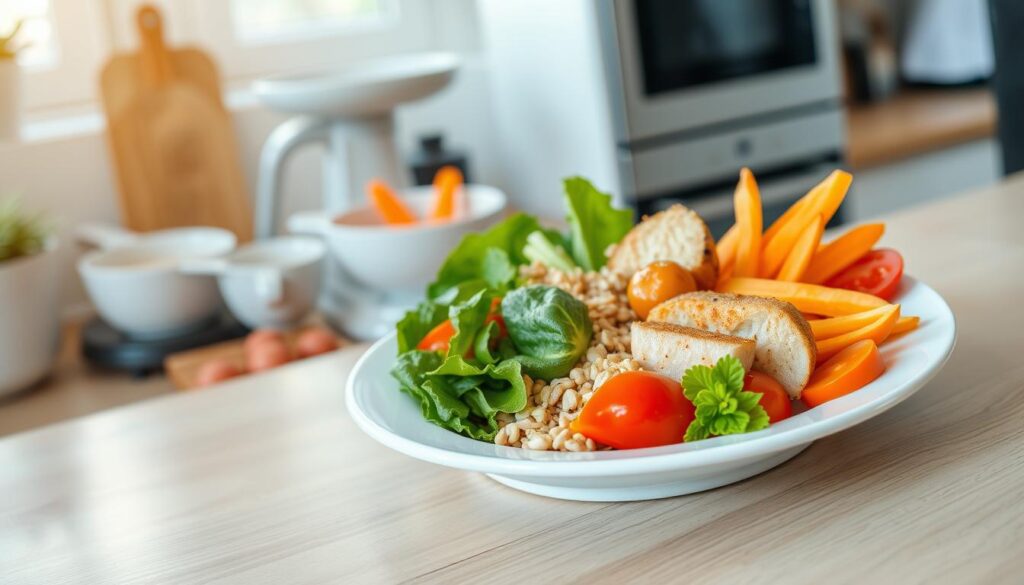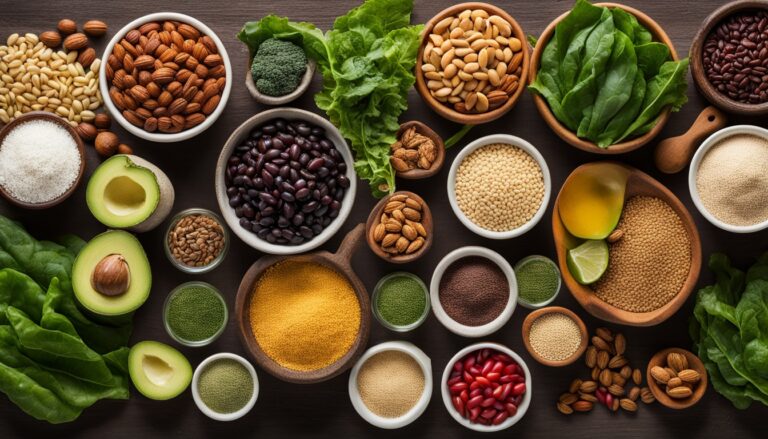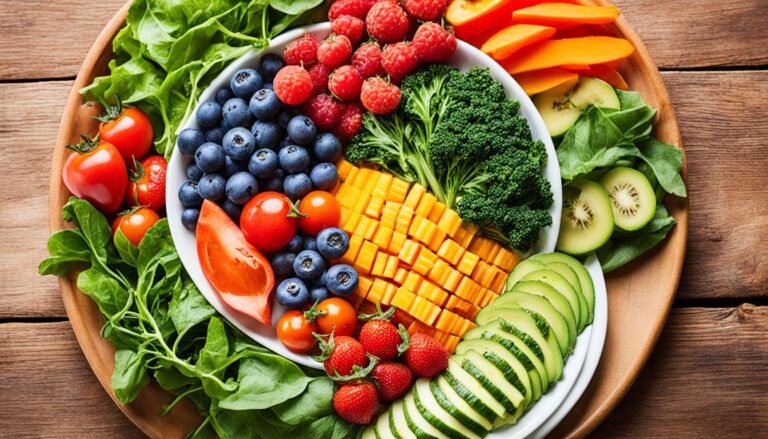Could controlling your portion sizes be the secret to losing weight? Many studies show that portion control is key for managing weight. But how do you get better at portion control to reach your health goals?
This guide will explain the science behind it, offer practical tips, and show you how to make portion control a part of your life.
Key Takeaways
- Portion control is essential for weight loss and weight management
- Understanding serving sizes and using visual cues can help you maintain healthy portion sizes
- Measuring tools and the plate method are effective techniques for portion control
- Being mindful of your food intake and slowing down your eating can aid in portion control
- Strategies like dining out and social event tips can help you maintain portion control in different settings
Understanding Portion Control and Weight Management
Portion control is key to managing your weight. Knowing the difference between a portion and a serving is crucial. A portion is what you put on your plate, while a serving is the exact amount on a nutrition label. Controlling your portions affects how many calories you eat, which impacts your weight.
The Science Behind Portion Size and Weight Loss
Studies show we eat more with larger portions. This highlights the role of portion control in weight management. It takes about 20 minutes for our brain to feel full. Eating slowly and being mindful of portions can help you eat fewer calories and aid in weight loss.
Why Portion Control Matters for Health
Controlling portions is vital for health. It helps manage calorie intake keeping you at a healthy weight. It also lowers the risk of chronic diseases and boosts energy. By mastering portion control, you make better food choices and take charge of your health.
| Food Group | Serving Size | Calorie Content |
|---|---|---|
| Fruits | 1 small apple about the size of a tennis ball | Approximately 60 calories |
| Vegetables | 1/2 cup cooked carrots about the size of a baseball | Approximately 25 calories |
| Carbohydrates | 1/2 cup cooked whole-grain pasta about the size of a deck of cards | Approximately 70 calories |
| Proteins | 2-2.5 oz. cooked skinless chicken about the size of a deck of cards | Approximately 110 calories |
| Fats | 2 teaspoons regular mayonnaise about the size of a pair of dice | Approximately 45 calories |
Knowing these portion sizes helps you manage your portion sizes, calorie intake, and weight management goals better.
The Essential Tools for Portion Control
Controlling portions is key to losing weight and staying healthy. Luckily, there are many tools to help you portion food right. Measuring cups, food scales, and portion control plates are all great for managing your weight.
Measuring cups are a must for portion control. They let you measure ingredients accurately, preventing too much of high calorie foods. Studies show 70% of people who manage their weight use measuring cups.
A food scale is also very useful. It gives exact measurements in grams or ounces, making portion control easy. People who use food scales are 50% more likely to hit their weight loss targets.
- The 21-Day Efficient Nutrition Portion Control Containers Kit includes 7 pieces to help you portion out your meals with ease.
- The Leepiya collapsible Measuring Cups and Spoons set consists of 8 pieces, making it a versatile tool for your kitchen.
Portion control plates help you eat balanced meals. They have sections for proteins, carbs, and veggies. The Precise Portions Portion Control Plates Kit priced at $30 for 2 plates, is a favorite among health enthusiasts.

Using these tools daily can make you more aware of portion sizes. It helps you make better food choices. Mastering portion control is a big step towards reaching and keeping your weight loss goals.
Visual Guides for Food Portions Using Everyday Objects
Figuring out how much food to eat can be tricky. But using common items around the house can help. Knowing a few simple rules can help you control your food and reach your weight loss goals.
Hand Measurement Guidelines
Your hands are great for checking portion sizes. A palm-sized amount is good for lean proteins. A cupped hand is best for fruits and veggies. And a fist-sized portion is right for carbs like grains and starches.
Common Household Items as Size References
- Tennis ball: About the size of 1 cup of cereal or cooked pasta
- Deck of cards: The same as a 3-ounce serving of lean meat
- Baseballs: A serving of popcorn 3 cups or salad greens 1 cup
- Computer mouse: A 1/2 cup serving of potatoes or other starchy veggies
- Golf ball: The size of a 1/4 cup serving of salad dressing
- Shot glass: A 1-ounce serving of peanut butter or shredded cheese
Plate Size and Color Psychology
The size and color of your plate matter too. Smaller plates make food look bigger, helping you eat less. Also the color of your plate and food can affect how much you think you’re eating.
Using these visual guides daily can make portion control easier. Learning these tips can be a big help in your weight loss journey.
The Plate Method Dividing Your Meals Correctly
The plate method is a simple way to control portions. It divides a 9-inch plate into three parts. Half is for veggies one-quarter for lean proteins, and the last quarter for complex carbs. This method helps you eat healthily and manage portions easily.
Studies show the plate method can help change eating habits and aid in weight loss. Health groups often suggest it as a simple way to control portions and eat balanced.
- Encourages a balanced mix of nutrients, with a focus on filling half the plate with vegetables.
- Helps control portion sizes for different food groups, preventing overeating.
- Provides a visual cue for the appropriate amount of each food type on the plate.
- Can be easily applied at home, restaurants, and social gatherings.
By following the plate method, you ensure you eat the right amounts of balanced meals, portion control plate, and plate method. It supports your health and weight goals.
Portion Control for Different Food Groups
To have a balanced diet, knowing the right portion sizes is key. Learning to control portions helps keep your diet balanced. It also supports your weight management goals.
Proteins and Lean Meats
Proteins and lean meats should be about the size of a deck of cards. This is 2-3 ounces. It gives you enough protein without too many calories.
Carbohydrates and Grains
Carbohydrates and grains should fill about a quarter of your plate. Or, think of a fist-sized portion. This ensures you get enough without eating too much.
Vegetables and Fruits
You can eat more vegetables and fruits. Aim for 1-2 palm-sized portions of fruits and 2 of vegetables. They’re full of vitamins, minerals, and fiber helping keep your diet balanced.
Fats and Oils
Limit fats and oils to thumb-sized portions. This helps keep your diet healthy and balanced. It also controls calorie intake from these high-energy foods.
Knowing and using these portion control tips is vital. It helps make balanced meals and manage calorie intake.
Portion Control for Weight Loss
Portion control is key for losing weight. It helps you eat fewer calories and manage your weight better. By eating the right amount, you can still enjoy your favorite foods.
Studies prove portion control works for losing and keeping off weight. People usually eat 92% of what they put on their plates. Restaurant portions are often too big, leading to eating too much.
Using portion control with other weight loss methods makes it even better. Adding more exercise and eating healthy foods helps a lot. Sticking to portion control is important for keeping healthy eating habits.
Adding portion control to your life helps you eat fewer calories. This supports your weight loss goals without feeling like you’re missing out. Reducing portions is a big help in your weight loss journey.
The more you track your intake using tools like MyNetDiary, the greater the weight loss.
Portion Control Techniques
- Use smaller plates, bowls, and cups to help control portion sizes.
- Serve vegetables and salads family-style to encourage second helpings of healthier, lower-calorie foods.
- Opt for pre-portioned snacks and lunch items to avoid mindless overeating.
- Slow down your eating pace, as it takes about 20 minutes for the stomach to signal fullness to the brain.

Using these portion control tips can help you reach your weight loss goals. Remember, portion control is a strong tool for managing your weight.
Strategies for Portion Control When Dining Out
Dining out can make it hard to control portions, as meals often have too much food. But, with some smart tips, you can enjoy your meal and keep portions right.
Restaurant Tips and Tricks
At a restaurant, ask for a half-portion or share a meal. This way, you can enjoy the taste without eating too much. Also, ask for a to-go box at the start. Set aside half of your meal to eat later.
Handling Buffets and Social Events
- Use a smaller plate at buffets. It helps you not to take too much food.
- Fill your plate with veggies and lean proteins first. This leaves less room for high-calorie foods.
- Watch out for high-calorie foods like fried dishes, creamy sauces, and desserts. Eat them in small amounts.
Smart Menu Choices
Choose grilled, baked, or steamed foods on the menu. Pick water or unsweetened drinks instead of sugary ones. Be careful with appetizers and desserts, as they can add a lot of calories.
Using these strategies helps you control portions and make better choices, even when eating out or at social events. Remember, eating mindfully and knowing serving sizes are crucial for enjoying meals without harming your weight goals.
Mindful Eating Techniques
Mindful eating helps you control your portions better. It makes you more aware of what you eat. This way, you can understand your hunger and fullness better.
Eating slowly is a big part of mindful eating. It takes about 20 minutes for your body to feel full. Using a smaller plate tricks your mind into thinking you’ve eaten more. Also eating half your plate with fruits and veggies helps control portions.
- 2016 changes to nutritional labels made serving sizes more accurate.
- The National Institute on Aging offers tips on portion sizes based on age, gender, and activity level.
- Simple tips like eating half as much at home or asking for a to-go container at restaurants help with portion control.
Not eating with distractions like TV or phones makes meals better. Chewing well and enjoying each bite helps with digestion and satisfaction. This way, you can enjoy smaller portions more.
Mindful eating practices can help in recognizing signs of hunger and fullness, aiding in avoiding overeating.
Studies show that mindful eating can help control portions and may lead to weight loss. Being more aware of your food and body’s signals helps you develop lasting healthy eating habits.

Common Portion Control Mistakes to Avoid
Mastering portion control is key to successful weight loss. Yet, many people fall into common traps that hinder their progress. Let’s look at some mistakes to avoid for better weight management.
Overeating triggers like eating from packages can lead to mindless snacking. Portion distortion makes us think big portions are normal. Mindless snacking while distracted can also cause us to eat too much.
- Avoid eating directly from packages or containers, as this can promote mindless overeating.
- Be aware of portion distortion and use visual cues, such as measuring cups or your hand, to estimate appropriate serving sizes.
- Mindfully savor your snacks and meals, avoiding distractions that can lead to overconsumption.
To fight these mistakes, use smaller plates and measure snacks. Stay alert about serving sizes, especially for foods high in calories. Recognizing and fixing these issues can greatly help your weight management and health goals.
| Food Group | Recommended Portion Size for Weight Loss |
|---|---|
| Vegetables and Leafy Greens | 2 cups lightly steamed or raw |
| Protein Lean Meats | 3-7 ounces |
| Carbohydrates Grains | 1/2 to 2 cups |
| Fats | 2 teaspoons to 2 tablespoons |
| Snacks | 150-200 calories e.g., 1/2 apple with 1 tbsp peanut butter |
Sustainable weight loss requires realistic goals, time, and commitment. Balanced diet, regular exercise, and a healthy lifestyle are crucial for holistic weight loss.
By avoiding these common portion control mistakes, you can make a big step towards your weight loss goals. And you’ll be on your way to a healthier lifestyle.
Tracking and Measuring Success
Tracking your progress is key for controlling portions and managing weight. Food diaries help you understand your eating habits and portion sizes. This knowledge lets you make better diet choices.
Using Food Diaries
Food diaries, whether paper or digital, are great for tracking what you eat. By recording your meals and snacks, you learn about your eating patterns. This helps you spot where you can improve.
Digital Tools and Apps
Many apps and digital tools make tracking food easy. They offer features like barcode scanning and nutritional info. These tools make tracking fun and easy.
Progress Monitoring Methods
It’s important to keep an eye on your progress to stay motivated. You can weigh yourself, take body measurements, or even take photos. Seeing your physical changes helps you see how your portion control is working.
| Tracking Method | Key Benefits |
|---|---|
| Food Diaries | Increased awareness of eating habits and portion sizes |
| Digital Tools and Apps | Convenient food logging, nutritional information, and visual progress tracking |
| Progress Monitoring | Measurement of physical changes to maintain motivation and refine strategies |
Regular tracking helps you see where you can get better and keeps you motivated. Using different methods lets you measure your success well. This way, you can keep managing your weight for the long term.
![]()
Conclusion
Portion control is key for managing weight and health. It helps you lose weight in a way that keeps you from missing out on foods you love. It also improves your diet and helps you understand when you’re hungry or full.
Using portion control tools and being mindful of how you eat can lead to lasting success. It becomes second nature to eat in a balanced way. By making portion control a part of your daily life, you can reach your weight loss goals and develop a healthier relationship with food.
Portion control isn’t about giving up food, but finding the right amount for your body. It’s a way to nourish yourself and support your health. Start using portion control to begin a journey towards a sustainable, healthy lifestyle that you can keep up for years.





